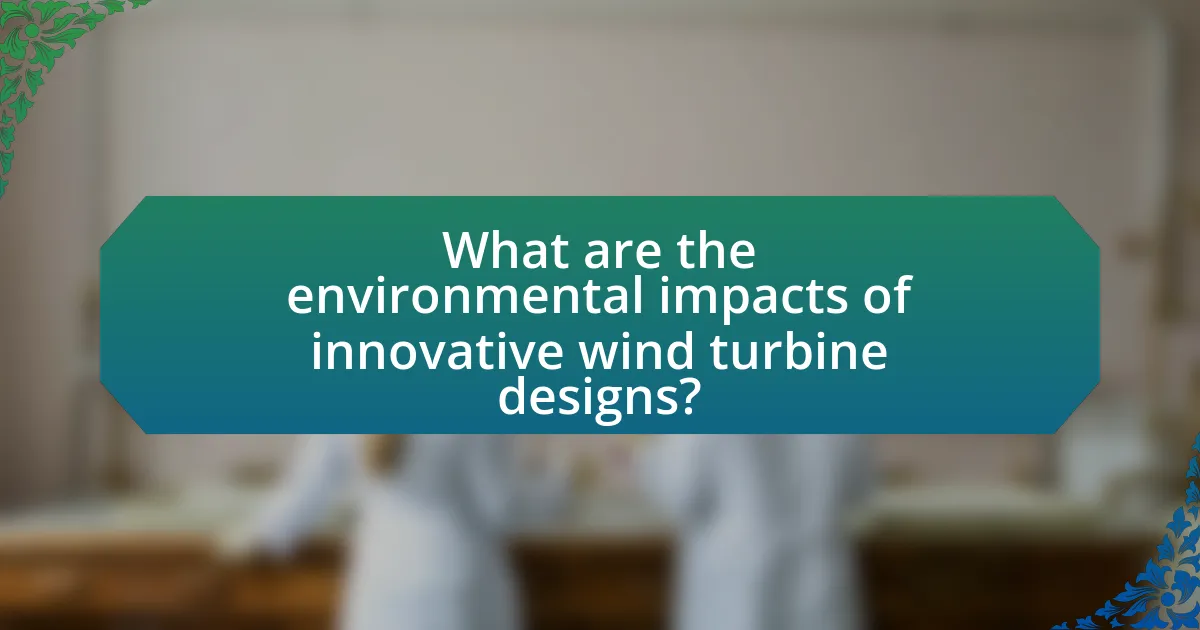The article focuses on innovations in wind turbine design aimed at increasing efficiency. Key advancements include larger rotor diameters, advanced blade materials such as carbon fiber composites, and improved aerodynamic shapes that enhance energy capture and reduce drag. The integration of technology, including data analytics and advanced control systems, further optimizes turbine performance and maintenance practices. Additionally, the article discusses the environmental impacts of these innovations, highlighting their role in reducing carbon footprints and minimizing ecological disruption. Future trends in turbine design, particularly in offshore environments, are also examined, emphasizing the importance of scale and innovative materials in enhancing energy production.

What are the key innovations in wind turbine design for increased efficiency?
Key innovations in wind turbine design for increased efficiency include larger rotor diameters, advanced blade materials, and improved aerodynamic shapes. Larger rotor diameters capture more wind energy, significantly increasing energy output; for instance, modern turbines can have rotor diameters exceeding 150 meters, which enhances their efficiency. Advanced blade materials, such as carbon fiber composites, reduce weight while maintaining strength, allowing for longer blades that can harness more wind. Additionally, improved aerodynamic shapes, including optimized blade profiles and pitch control systems, enhance performance by maximizing lift and minimizing drag, leading to efficiency gains of up to 20% in some designs. These innovations collectively contribute to the overall effectiveness and energy production capabilities of contemporary wind turbines.
How have materials technology advancements impacted wind turbine efficiency?
Materials technology advancements have significantly enhanced wind turbine efficiency by enabling the development of lighter, stronger, and more durable components. For instance, the introduction of advanced composite materials, such as carbon fiber and fiberglass, has allowed for larger rotor blades that can capture more wind energy while maintaining structural integrity. Research indicates that these materials can reduce the weight of turbine components by up to 30%, leading to improved energy output and reduced maintenance costs. Additionally, innovations in coatings and surface treatments have minimized drag and increased the lifespan of turbine parts, further contributing to overall efficiency improvements.
What new materials are being used in turbine blades?
New materials being used in turbine blades include carbon fiber composites and advanced ceramics. Carbon fiber composites offer high strength-to-weight ratios, enhancing the structural integrity and efficiency of turbine blades while reducing overall weight. Advanced ceramics provide excellent thermal resistance and durability, allowing blades to withstand extreme conditions and improve performance. Research has shown that these materials can significantly increase the lifespan and efficiency of turbine blades, contributing to advancements in wind turbine design.
How do these materials enhance performance and durability?
Advanced materials enhance performance and durability in wind turbine design by providing superior strength-to-weight ratios and resistance to environmental factors. For instance, carbon fiber composites are lighter and stronger than traditional materials, allowing for larger blades that capture more wind energy while reducing structural stress. Additionally, these materials exhibit high resistance to corrosion and fatigue, which extends the lifespan of turbine components. Research indicates that using advanced composites can increase turbine efficiency by up to 15% and significantly reduce maintenance costs due to their durability in harsh conditions.
What design modifications have been implemented to improve aerodynamics?
Design modifications implemented to improve aerodynamics in wind turbine design include the optimization of blade shape, the introduction of serrated trailing edges, and the use of advanced materials. These modifications enhance airflow over the blades, reducing drag and increasing lift. For instance, research has shown that blades with an optimized airfoil shape can improve energy capture by up to 15%. Additionally, serrated trailing edges have been found to reduce noise and improve performance in turbulent conditions, further contributing to overall efficiency.
How do blade shape and size influence energy capture?
Blade shape and size significantly influence energy capture in wind turbines by affecting aerodynamic efficiency and the amount of wind energy converted into mechanical energy. Larger blades can sweep a greater area, capturing more wind, while specific shapes, such as those designed with an airfoil profile, optimize lift and reduce drag, enhancing overall performance. Research indicates that increasing blade length by 10% can improve energy capture by approximately 5-10%, depending on wind conditions and turbine design. Additionally, the angle of attack and curvature of the blades play crucial roles in maximizing energy extraction, as they determine how effectively the blades interact with the wind flow.
What role does rotor design play in overall efficiency?
Rotor design is crucial for overall efficiency in wind turbines as it directly influences the energy capture and aerodynamic performance. A well-designed rotor maximizes the lift-to-drag ratio, allowing turbines to harness wind energy more effectively. For instance, rotor blades with optimized shapes and materials can increase energy output by up to 20%, as demonstrated in studies by the National Renewable Energy Laboratory, which found that advanced blade designs significantly enhance performance under varying wind conditions. Therefore, rotor design is a key factor in improving the efficiency and effectiveness of wind energy systems.
How is technology integration transforming wind turbine operations?
Technology integration is transforming wind turbine operations by enhancing efficiency, reliability, and maintenance practices. Advanced data analytics and IoT sensors enable real-time monitoring of turbine performance, allowing for predictive maintenance that reduces downtime and operational costs. For instance, a study by the National Renewable Energy Laboratory found that predictive maintenance can decrease maintenance costs by up to 30% and increase turbine availability by 10%. Additionally, machine learning algorithms optimize energy output by adjusting turbine settings based on environmental conditions, leading to improved energy capture. These technological advancements collectively contribute to more efficient wind energy production and operational sustainability.
What advancements in control systems are enhancing turbine performance?
Advancements in control systems, such as model predictive control (MPC) and advanced sensor integration, are significantly enhancing turbine performance. Model predictive control optimizes turbine operation by predicting future states and adjusting control inputs accordingly, leading to improved energy capture and reduced loads on turbine components. Advanced sensor integration allows for real-time monitoring of environmental conditions and turbine health, enabling adaptive control strategies that enhance efficiency and reliability. For instance, studies have shown that implementing MPC can increase energy output by up to 10% compared to traditional control methods, demonstrating the effectiveness of these advancements in maximizing turbine performance.
How does data analytics contribute to operational efficiency?
Data analytics enhances operational efficiency by enabling organizations to make data-driven decisions that optimize processes and resource allocation. By analyzing performance metrics, companies can identify inefficiencies, predict maintenance needs, and streamline operations. For instance, in the wind turbine industry, data analytics can monitor turbine performance in real-time, allowing for proactive maintenance that reduces downtime and increases energy output. According to a report by the International Renewable Energy Agency, predictive maintenance can reduce operational costs by up to 30%, demonstrating the tangible benefits of data analytics in improving efficiency.

What are the environmental impacts of innovative wind turbine designs?
Innovative wind turbine designs primarily reduce environmental impacts by increasing energy efficiency and minimizing land use. These designs often incorporate advanced materials and technologies, such as lighter blades and improved aerodynamics, which enhance energy capture while reducing the overall footprint of wind farms. For instance, the use of composite materials can lead to lighter structures that require less material, thereby decreasing resource extraction and manufacturing emissions. Additionally, innovations like vertical-axis wind turbines can be installed in urban areas, reducing habitat disruption and allowing for energy generation in previously unsuitable locations. Studies have shown that modern wind turbines can produce energy with a lifecycle carbon footprint significantly lower than fossil fuels, often around 15 grams of CO2 per kilowatt-hour, compared to over 900 grams for coal. This demonstrates that innovative designs not only improve efficiency but also contribute to lower greenhouse gas emissions, supporting climate change mitigation efforts.
How do new designs minimize ecological disruption?
New designs in wind turbine technology minimize ecological disruption by incorporating features that reduce wildlife impact and enhance site compatibility. For instance, advancements such as bird and bat detection systems allow turbines to temporarily shut down during high-risk periods, significantly decreasing avian fatalities. Additionally, the use of smaller, more efficient turbine models enables installation in less sensitive areas, thereby preserving local ecosystems. Research indicates that these innovations can lead to a 50% reduction in wildlife collisions compared to traditional designs, demonstrating their effectiveness in mitigating ecological harm.
What measures are taken to protect local wildlife?
Measures taken to protect local wildlife include implementing bird and bat monitoring programs, establishing setback distances from habitats, and utilizing wildlife-friendly turbine designs. These strategies aim to minimize the impact of wind turbines on local fauna. For instance, studies have shown that proper siting and design can reduce avian fatalities by up to 50%. Additionally, the use of radar technology to detect flying animals allows for real-time adjustments to turbine operations, further safeguarding wildlife.
How do innovative designs reduce noise pollution?
Innovative designs in wind turbines reduce noise pollution primarily through aerodynamic improvements and advanced materials. These designs often feature blade shapes that minimize turbulence and optimize airflow, resulting in quieter operation. For instance, the use of serrated or tapered blade edges can significantly decrease the noise generated by the blades as they cut through the air. Research conducted by the National Renewable Energy Laboratory indicates that modern turbine designs can reduce sound levels by up to 10 decibels compared to older models, demonstrating a clear advancement in noise reduction technology.
What is the lifecycle impact of modern wind turbines?
The lifecycle impact of modern wind turbines is predominantly positive, characterized by low greenhouse gas emissions and reduced reliance on fossil fuels. Over their operational lifespan, which typically spans 20 to 25 years, wind turbines generate significantly more energy than is consumed in their manufacturing, installation, and decommissioning processes. For instance, studies indicate that wind turbines can produce 20 times the energy used in their lifecycle, with a carbon payback period of approximately six months to a year, depending on the location and technology used. Additionally, advancements in turbine design, such as larger rotor diameters and improved materials, have further enhanced energy efficiency and reduced environmental footprints.
How do new materials affect recyclability and sustainability?
New materials significantly enhance recyclability and sustainability by improving the lifecycle management of products. For instance, advanced composites used in wind turbine blades, such as thermoplastic resins, allow for easier disassembly and recycling at the end of their operational life. Research indicates that these materials can be recycled into new products, reducing waste and resource consumption. Additionally, the use of bio-based materials in turbine design contributes to sustainability by lowering carbon footprints during production and disposal. Studies show that integrating such materials can lead to a reduction in greenhouse gas emissions by up to 30% compared to traditional materials.
What are the carbon footprints of innovative wind turbine designs?
Innovative wind turbine designs typically have a carbon footprint ranging from 10 to 20 grams of CO2 equivalent per kilowatt-hour (gCO2e/kWh) of electricity generated. This low carbon footprint is primarily due to the renewable nature of wind energy, which does not produce direct emissions during operation. Additionally, advancements in materials and manufacturing processes, such as the use of lighter and more durable composites, have further reduced the carbon emissions associated with the production and installation of these turbines. For instance, a study by the National Renewable Energy Laboratory found that modern wind turbines can achieve a lifecycle carbon footprint that is significantly lower than fossil fuel-based energy sources, reinforcing the environmental benefits of innovative designs in the wind energy sector.

What are the future trends in wind turbine design for enhanced efficiency?
Future trends in wind turbine design for enhanced efficiency include the development of larger rotor diameters, advanced materials, and innovative blade designs. Larger rotor diameters increase the swept area, allowing turbines to capture more wind energy, which can lead to a significant increase in energy output. Advanced materials, such as carbon fiber composites, reduce weight while maintaining strength, enabling longer and more efficient blades. Additionally, innovative blade designs, including adaptive and variable pitch blades, optimize performance across varying wind conditions, enhancing overall efficiency. These trends are supported by ongoing research and advancements in technology, demonstrating a clear trajectory towards more efficient wind energy generation.
How is the trend towards larger turbines influencing efficiency?
The trend towards larger turbines significantly enhances efficiency by increasing energy capture from wind resources. Larger turbines have longer blades, which allow them to harness more wind energy at lower wind speeds, resulting in higher energy output. For instance, a study by the National Renewable Energy Laboratory found that turbine capacity factors improve as rotor diameters increase, with modern turbines achieving capacity factors above 50% compared to older models that often fell below 30%. This increase in efficiency is crucial for maximizing energy production and reducing the cost per megawatt-hour, making wind energy more competitive with fossil fuels.
What are the benefits of increasing turbine size?
Increasing turbine size enhances energy capture and efficiency in wind energy production. Larger turbines can harness more wind energy due to their increased rotor diameter, which allows them to access higher wind speeds at greater heights. For instance, a turbine with a rotor diameter of 150 meters can generate significantly more power than a smaller turbine, as it can capture wind over a larger area, leading to higher annual energy output. Additionally, larger turbines often have advanced technology that optimizes performance, such as improved blade design and control systems, which further increases their efficiency. Studies have shown that modern large-scale turbines can achieve capacity factors exceeding 50%, compared to smaller models that typically range from 30% to 40%. This increase in efficiency translates to lower cost per megawatt-hour, making wind energy more competitive with fossil fuels.
How does scale affect energy output and cost-effectiveness?
Scale significantly enhances energy output and cost-effectiveness in wind turbine design. Larger turbines can capture more wind energy due to increased rotor diameter and height, leading to higher energy production. For instance, a 2 MW turbine can generate approximately 6 million kWh annually, while a 10 MW turbine can produce around 30 million kWh, demonstrating a direct correlation between size and output. Additionally, economies of scale reduce the cost per megawatt-hour; larger installations benefit from lower operational and maintenance costs per unit of energy produced. Research indicates that the cost of energy from offshore wind projects has decreased by 70% since 2010, largely due to advancements in turbine scale and technology.
What role does offshore wind energy play in future designs?
Offshore wind energy is crucial in future designs as it significantly enhances the efficiency and scalability of renewable energy systems. The integration of offshore wind farms allows for larger turbines that can harness stronger and more consistent winds, leading to higher energy output. For instance, the Global Wind Energy Council reported that offshore wind capacity reached 35 gigawatts in 2020, demonstrating rapid growth and potential for future expansion. This capacity enables the development of innovative turbine designs that can operate in deeper waters, utilizing advanced materials and technologies to improve performance and reduce costs.
How do offshore turbines differ from onshore designs?
Offshore turbines differ from onshore designs primarily in their structural engineering and operational environment. Offshore turbines are typically larger, with taller towers and longer blades, designed to withstand harsher marine conditions, including stronger winds and saltwater corrosion. For instance, offshore turbines can reach heights of over 100 meters and blade lengths exceeding 80 meters, compared to onshore turbines, which generally have shorter towers and blades. Additionally, offshore installations benefit from higher wind speeds and more consistent wind patterns, leading to increased energy generation efficiency. According to the Global Wind Energy Council, offshore wind farms can produce up to 50% more energy than their onshore counterparts due to these favorable conditions.
What innovations are being developed specifically for offshore environments?
Innovations being developed specifically for offshore environments include floating wind turbines, advanced materials for turbine blades, and enhanced energy storage systems. Floating wind turbines allow for deployment in deeper waters where traditional fixed turbines are not feasible, significantly increasing the potential for energy generation. Advanced materials, such as carbon fiber composites, improve the durability and efficiency of turbine blades, enabling them to withstand harsh marine conditions. Enhanced energy storage systems, including battery technology and hydrogen production, facilitate the integration of renewable energy into the grid by addressing intermittency issues. These innovations are crucial for maximizing the efficiency and sustainability of offshore wind energy production.
What best practices should be followed for optimizing wind turbine efficiency?
To optimize wind turbine efficiency, best practices include selecting appropriate turbine design, ensuring proper site assessment, and implementing regular maintenance. The selection of turbine design should consider factors such as rotor diameter and blade shape, which significantly influence energy capture; for instance, larger rotor diameters can harness more wind energy. Proper site assessment involves analyzing wind patterns and terrain to maximize energy production; studies show that turbines placed in areas with consistent wind flow can increase output by up to 30%. Regular maintenance, including inspections and repairs, ensures that turbines operate at peak performance, as neglect can lead to efficiency losses of 10% or more.
How can regular maintenance improve turbine performance?
Regular maintenance enhances turbine performance by ensuring optimal operational conditions and preventing mechanical failures. Routine inspections and servicing, such as lubricating moving parts and checking for wear, can significantly reduce downtime and improve energy output. For instance, studies indicate that well-maintained turbines can operate at up to 98% of their rated capacity, compared to only 85% for poorly maintained units. This increase in efficiency directly correlates with higher energy production and reduced operational costs, validating the importance of regular maintenance in maximizing turbine performance.
What operational strategies maximize energy production from wind turbines?
Operational strategies that maximize energy production from wind turbines include optimizing turbine placement, implementing advanced control systems, and conducting regular maintenance. Optimizing turbine placement involves selecting locations with consistent wind patterns and minimal turbulence, which can increase energy capture by up to 20%. Advanced control systems, such as pitch control and yaw control, allow turbines to adjust their blade angles and orientation in real-time to maximize energy output based on wind conditions. Regular maintenance ensures that turbines operate at peak efficiency, reducing downtime and maintaining energy production levels. These strategies collectively enhance the overall performance and reliability of wind energy systems.




